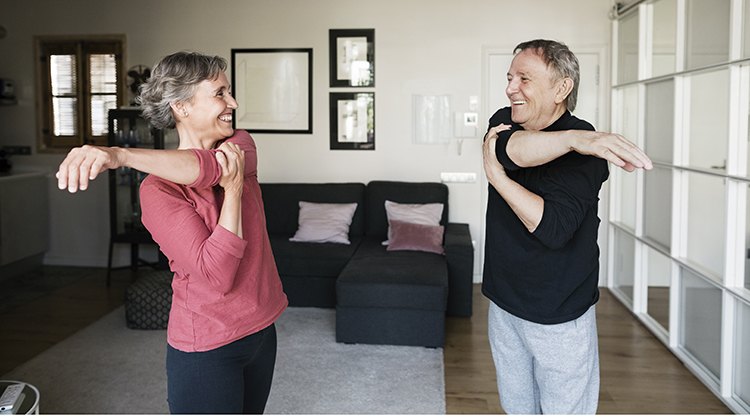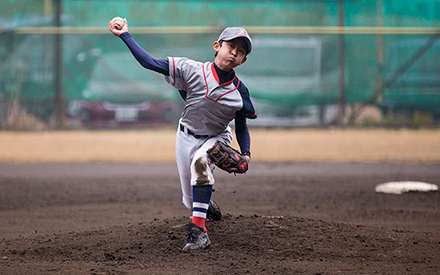
Physical ability changes as we get older, but staying active helps to keep us healthy.
As we age, strength, balance, and coordination can diminish if they are not being challenged and practiced often. Loss of these abilities can make it a challenge to do everyday activities.
Regular physical activity can benefit your physical, mental, and social health. It also can help you prevent or improve many chronic conditions, such as heart disease, diabetes, obesity, depression, and some cancers (HHS). For substantial health benefits, adults (ages 18 through 64 years, with and without chronic health conditions and disabilities, who are able) should do:
- At least 150 minutes to 300 minutes a week of moderate-intensity aerobic physical activity.
- Or, 75 minutes to 150 minutes a week of vigorous-intensity aerobic physical activity.
- And, strengthening exercises two days per week.
Including the following exercises into your daily physical activity routine can help you keep your strength, agility, and balance.
Visit our health center for older adults for additional resources. Also, for additional exercises (including video instructions for people who use a cane, walker, or walk without assistance), see Maintaining Health and Fitness: Tips and Exercises for Older Adults.
1. Sidewalking.
Walking sideways "wakes up" the hip muscles on the sides of the pelvis, which are essential to support the knees, ankles, and spine. They also assist in keeping your balance when walking.
What to do: Several times per day, step 10 times to the right, followed by stepping 10 times to the left. Keep hands on a kitchen counter or long table while sidestepping if you need support. To make it more challenging, tie an exercise band around your thighs, just above the knees, to create resistance.
2. Shoulder blade squeezes.
Many people develop a forward-curved posture, usually due to sitting in poor posture (such as working at a computer). This head-forward and rounded-shoulder posture can reduce how deeply we can inhale. It also can cause neck and back pain.
What to do: Several times per day, squeeze shoulder blades together and downward. Hold for three seconds. Repeat 10 times. This exercise can help you stand up straighter and even breathe more deeply.
3. Abdominal drawing-in.
Our abdominal muscles support the spine. These muscles can become weaker unless they are exercised. Weak abdominals can increase your risk for back pain.
What to do: Several times per day, pull your belly button inward toward your spine. Hold for three seconds, without holding your breath. Repeat 10 times. As you get used to doing this, try doing it when you are walking, exercising, and during all other activities. It can protect your back from injury and pain.
4. Balancing.
Good balance may come naturally to some people, but we can become less skilled with balance if we are inactive. It is important to do exercises to challenge your balance. Good balance helps prevent falls and related injuries.
What to do: Several times per day, stand on both feet with your hands on a kitchen counter or a sturdy table. Slowly lift one foot and try to balance on the other foot for 10-15 seconds. Then do the same thing on the other foot. Repeat five times on each foot. If this is easy, try closing your eyes while standing on both feet. If that is easy, close your eyes while standing on one foot. Be sure to have someone standing close by to help you avoid falling.
5. Stand up and sit down.
The strength and endurance of the hip and thigh muscles determine how well older adults can get around their homes and the community. If these muscles lose strength, standing and walking can become a challenge.
What to do: Several times per day, sit in a sturdy chair with no armrests. Stand up and sit back down, rising and lowering in a controlled motion. Do this slowly five times. Then do it more quickly, five times. You can use your hands to help you, if you need to, at first. Try to work toward not needing to use your hands. Over time, this exercise can help your leg muscles feel stronger.
6. Pelvic floor training.
Pelvic floor muscles (the muscles that we sit on) play an important role in urine and bowel movement control, spine support, and sexual response. The pelvic floor muscles can lose strength with illness, weight gain, and an inactive lifestyle (too much sitting). Loss of pelvic floor muscle strength can occur in both men and women, and with pregnancy.
What to do: Several times per day, squeeze the muscles in your pelvic floor area as if attempting to stop the flow of urine or hold back gas. Hold for three to five seconds. Repeat up to 10 times. Do not tighten your leg, hip, or abdominal muscles or hold your breath when you do this exercise.
7. Front and back stepping.
Coordination and agility are not just for athletes; they are also essential for all of us. Loss of coordination and agility can occur with aging or inactivity. It also can lead to an increased risk of falls and related injuries.
What to do: One time or more per day, with your hands on the kitchen counter or a long sturdy table, cross your right leg in front of your left leg, and stand on your right foot. Carefully lift the left foot and step out to the left. Then cross your right leg behind the left leg, and stand on your right foot. Again, carefully lift the left foot and step out to the left. Repeat two more times.
Then, carefully change directions, and do this exercise to the right side. Start by crossing the left leg in front of the right leg.
This exercise is a little more complex, so be sure to have someone standing close by to help you avoid falling. If you are experiencing issues with your strength, balance, or coordination, speak with a physical therapist.
Physical therapists are movement experts. They improve quality of life through hands-on care, patient education, and prescribed movement. You can contact a physical therapist directly for an evaluation. To find a physical therapist in your area, visit Find a PT.


